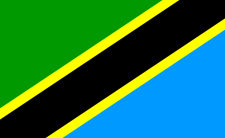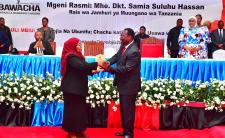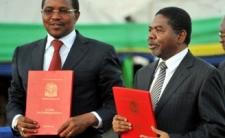Background
The United Republic of Tanzania consists of main land Tanganyika and the island of Zanzibar. It shares boundaries with Kenya and Uganda to the north; Rwanda, Burundi, and the Democratic Republic of Congo to the west; Zambia, Malawi, and Mozambique to the south; and the Indian Ocean to the east. The population is approximately 48 million. There are approximately 130 different ethnic groups in Tanzania, and the official languages are Kiswahili and English. Many also speak Arabic and several other indigenous languages. Tanzania’s economy depends heavily on agriculture and tourism.
The region Tanganyika and Zanzibar were part of the former German colony of German East Africa, which was transferred to the UK following the end of World War I as a League of Nations’ mandate territory. After World War II, it was converted to a United Nations Trust Territory. Great Britain and Tanganyika nationalists negotiated a constitution for an independent Tanganyika in 1961. The Constitution, based on the Westminster system, established a constitutional monarchy with Queen Elizabeth II as the formal head of state, represented by a Governor General. Executive authority was vested in a Prime Minister. The Constitution did not have a Bill of Rights, which was a concession the British made to the Tanganyika nationalists. The independence movement was cooperative, driven by closely-connected political and civic groups. Civic groups and trade unions provided nationalist leaders forums through which they could address the public. The Constitution provided the legal framework for multiparty democracy.
In 1962, the document was drastically revised by the Tanganyika African National Union (TANU), which was the dominant party in Tanganyika. The revision replaced the multi-party parliamentary system with a one party presidential system with the Governor General as president First Minister, the Head of State, and Commander-in-Chief of the armed forces. He was granted powers to appoint the vice president and ministers and to dismiss Parliament under certain circumstances. The Preventive Detention Act also gave the President unilateral powers to authorise detentions without trial. This revised constitution lasted until 1964 when Tanganyika and Zanzibar merged to become the United Republic of Tanzania.
Zanzibar became independent on December 19, 1963. The Independence Constitution was drafted at a Constitutional Conference in Lancaster House following negotiations between the colonial powers and the two major political parties: the Zanzibar Nationalist Party (ZNP)—which represented the Arab population— and the Afro-Shirazi Party (ASP)—which represented the African population. Like Tanganyika, Zanzibar’s independence Constitution established a constitutional monarchy, though its constitution included a bill of rights and proclaimed the Sultan of Zanzibar the ceremonial Head of State. The ASP was not satisfied with this constitution, however, claiming it allowed electoral boundaries to be gerrymandered in favour the Sultanate of Zanzibar. On January 12, 1964, the ASP led a revolution, ousting the Zanzibar Arabs from power and abolishing the Sultanate. They also repealed the constitution and replaced it with a series of presidential decrees. Under this system, the president exercised all executive and legislative authority on behalf of the Revolutionary Council. To consolidate its position and avert a counter revolution, the ASP formed a union with Tanganyika in April 1964.
A new interim Constitution was passed in 1964, recognizing all the changes brought by the Union and proposals made by a One Party Commission. The interim Constitution placed fundamental rights and freedoms in the preamble and established a two -tier government consisting of a national government and the semi-autonomous government of Zanzibar. The Zanzibar government had its own Parliament and President, who also served as the Vice President of Tanzania. In 1965 the Constitution was amended to introduce single party rule led by TANU on the national level, but allowed the Afro-Shirazi Party to continue in Zanzibar. Although initially intended to last a year, the interim Constitution was in place until 1977, with the addition of several amendments to strengthen TANU’s rule and weaken Zanzibar’s autonomy.
On February 5, 1977, TANU and ASP merged to become Chama Cha Mapinduzi (CCM-Party of the Revolution). On March 16, 1977, President Julius Nyerere appointed a twenty-person committee, led by Thabit Kombo (a former secretary general of the ASP), to make proposals for a constitution for the United Republic. On March 16, 1977, President Nyerere also convened a Constituent Assembly to discuss and enact the new constitution. The Constitution essentially confirmed the provisions of the interim constitution: a strong presidency, single party rule, and retention of the two-tier structure of government. Under this constitution, a candidate for the Zanzibar president would be selected by a special committee of the Central Committee of CCM. That name would be confirmed by the National Executive Committee of the CCM and forwarded to the Revolutionary Council of Zanzibar for approval or rejection.
In 1979, Zanzibar adopted a new constitution, almost identical to the national Tanzania constitution. The new Constitution provided the same organization of government as the national constitution and endorsed all its provisions. Presidential selection became slightly more democratic, with a special committee submitting two candidates to the National Executive Committee, which would select one candidate. The name of that candidate would then be put before the electorate, rather than the Revolutionary Council. The 1979 Constitution established an elected House of Representatives and empowered it with legislative powers over all non-Union matters, fundamentally eroding the power of the Revolutionary Council. This constitution did not include a bill of rights.
In 1983, new constitutional debates started in Tanzania with the ruling CCM setting the agenda for change. The three main areas for analysis and possible reform were: executive powers, supremacy of parliament, and participatory democracy. In 1984, the Constitution was amended to include a bill of rights. The 1984 amendments also limited the presidential mandate to two terms and introduced a system of two Vice-Presidents, whereby at any time, one shall be the President of Zanzibar and the other the Prime Minister of Tanzania.
Developments in the 1990s
Key Country Documents Index
The collapse of the Soviet Union and other external influence highlighted the need for more constitutional reform in Tanzania. On March 26, 1991, President Ali Hassan Mwinyi appointed a commission under the Chairmanship of Chief Justice Francis Nyalali to collect views on what type of political system Tanzanians would like. The Nyalali Commission had one year to complete its work. The Commission’s report called for a repeal of the 1977 Constitution as well as forty additional laws that the commission felt were undemocratic and contrary to established human rights. The Commission found that although 77.2% of those interviewed preferred Tanzania to continue with its current system, the changes requested could only be accommodated under a multiparty system. Consequently, on May 29, 1992, Tanzania passed the Political Parties Act, allowing for a multiparty system.
This change, however, did not eliminate the calls for a new constitution, which the Nyalali Commission had recommended. In 1998, to appease the mounting pressure, the ruling party decided to float a White Paper on constitutional change. A Committee of 16 members was appointed led by Hon. Mr. Justice Robert Kisanga of the Court of Appeal of Tanzania. The Committee visited and collected views from all districts and presented an over 800 page report to President Benjamin Mkapa in 1999. However, the government ignored many of the Committee’s recommendations, arguing that they were not in line with the views of the people. As a result, the 1977 Constitution has remained in place to date.
The 1977 Constitution
The 1977 Constitution provides for a strong presidential system and a two-tier government: a Zanzibar government and a Union government. The executive powers belong to the Government of the United Republic and the Government of Tanzania Zanzibar. Legislative and supervisory powers over public affairs are vested in the Parliament of the United Republic and the House of Representatives of Zanzibar. Judicial powers are exercised by the Judiciary of the United Republic and the Judiciary of Tanzania Zanzibar. The Union Government is primarily responsible for the governance of the state.
Executive branch
The President of the United Republic is Head of State, Government, and Commander-in-Chief of the Armed Forces. The Government of the United Republic has authority over all Union matters and matters concerning Mainland Tanzania. He can be removed from power by the Cabinet if he is found incapable of discharging his duties due to mental or physical infirmities. The Cabinet must get this declaration certified by the Chief Justice and present it to the Speaker. A candidate for President must be a natural born citizen, at least 40 years of age, supported by a political party, eligible to be a member of parliament. The Prime Minister and the Cabinet form the government, are appointed by the President and are responsible to him.
The President of Zanzibar is the Head of the Revolutionary Government of Zanzibar, which has authority in Zanzibar over all non-Union matters.
Legislative branch
Legislative power of the United Repupblic is jointly exercised by Union Parliament and the President of the Republic. Parliament consists of 357 MPs elected for five year terms. There are six categories of MPs: (1) the President and Vice President; (2) MPs elected by constituencies; (3) ten appointed by the President; (4) five elected by the members of Tanzania Zanzibar House of Representatives; (5) the Attorney General; and (6) the Speaker if he is not elected from among the members. The Constitution mandates a thirty percent quota for female representatives. To be eligible for parliament, a person must be at least 21 years old, able to read and write English or Kiswahili, and a citizen of Tanzania. A candidate must also have the support of one of the political parties. Parliament deals with all matters concerning the Union and mainland Tanganyika.
Judicial branch
The highest judicial authorities in Tanzania are the High Court and the Court of Appeal. The High Court is composed of a Principal Judge and 30 other judges. Judges are appointed by the President after consultation with the Judicial Service Commission. The High Court has unlimited jurisdiction over all civil and criminal matters. The High Court has appellate power over points of law and points of fact. A fifteen member Court of Appeals was established in 1979. It hears and determines every appeal brought before it arising from the judgment or other decision of the High Court or of a magistrate with extended jurisdiction.
A Special Constitutional Court (SCC) has jurisdiction over the interpretation of the constitution where such interpretation relates to disputes between Zanzibar and the United Republic. The SCC does not have the power to inquire into or alter decisions by the High Court or the Court of Appeals. Every conciliatory decision given by the SCC is final. The Governments of the Republic and Zanzibar each appoint half of the members of the SCC.
Recent Constitutional developments
In 2011, the government launched a process to draft a new constitution for the country. The goal was to draft a more legitimate and nationally owned constitution. On 30 November 2011, Parliament enacted the Constitutional Review Act (CRA) establishing the Tanzanian Constitutional Review Commission to collect public opinions on the review of the Constitution and validation via a referendum. Key issues to be addressed—referred to as “inviolable matters” in the draft legal framework for the process—included the state of the Tanzanian union, the presidency, and human rights, although the latter was not open to public discussion. This provoked strong public and civil society protests, leading to the withdrawal of the bill. This withdrawal was, however, only short-lived as, as it was subsequently reintroduced and passed into law as the CRA or the Act. The Act gave the President power to appoint members of the Commission and to issues the Commission’s Terms of Reference.
On 6 April 2012 President Kikwte appointed a thirty-member Commission with former Attorney General and Prime Minister Joseph Warioba as Chairman and former Chief Justice Augustino Ramadhani as Vice Chairman. There were fifteen members from mainland Tanzania and fifteen from Zanzibar. Selection of members was made from a pool of 550 candidates proposed by political parties, religious institutions, NGOs, and other stakeholders. The Commission collected public views through telephone calls, emails, blogs, and social networks. It also conducted country-wide meetings with the public. The Commission was split into seven groups to visit different regions in the country. By October 10, 2012, more than 500,000 Tanzanians had expressed their views on a new constitution, and the Commission released its draft Constitution on June 3, 2013.
The next phase of the process started on July 5, 2013 with the consultative process. The constitutional review councils created for each district reviewed the first draft and submitted changes to the Commission. The Commission then submitted the draft to the National Constituent Assembly, dominated by members of Parliament, for review and adoption. The president received a second draft from the Constitution Review Commission on December 30, 2013, to be discussed by the Constituent Assembly.
One of the more contentious proposals of the new constitution involves changing from a two-tier to three-tier government structure. Currently, Zanzibar has a government and the Unity government oversees both Tanganyika and the country as a whole. A three-tier structure would create a separate Tanganyika government. However, some feel such a change would place considerable financial strain on the state. Other changes include raising the quota for female representation in Parliament from 30% to 50%, expansion of the Bill of Rights, establishment of a Supreme Court, and limiting members of Parliament to three five-year terms.
The Constituent Assembly was given 70 days from its first meeting to make a decision on the Constitution. That deadline expired on April 26, 2014. In early April, the Assembly requested that the deadline be pushed back in order for it to focus on approving a national budget for the 2015 fiscal year. The CA was given an extension of 60 days after it resumes in August. In mid-April, the Ukawa party, which forms more than one third of the CA, walked out, claiming that the draft was promoting segregation. A two thirds vote is necessary for the Constitution to pass.
System of Government under 1977 Constitution
Timeline
| 800s |
Kilwa is established as a trading settlement by Arabs, whilst Persian traders settle at Pemba and on Zanzibar |
| 1498 |
Vasco de Gama becomes the first European to sail up the Tanzanian coast. |
| 1503 | Zanzibar becomes a Portuguese colony |
| 1699 | Portuguese ousted as Zanzibar comes under the control of the Sultan of Oman |
| August 1907 | Eng of the Maji Maji Rebellion against German colonial rule in East Africa. |
| 10 January 1920 |
Tangayika becomes a League of Nations Mandate Territory under Britain |
| 13 December 1946 | Tangayika becomes a UN TrustTerritory under Britain |
| 9 December 1961 | Tanganyika becomes autonomous commonwealth, with a constitutional monarch. |
| 9 December 1962 | Tanganyika becomes a republic with a presidential system |
| 19 December 1963 | Zanzibar becomes independent from the UK with a constitutional monarchy. |
| 12 January 1964 | Afro-Shirazi Party overthrow the Sultan in Zanzibar |
| 26 April 1964 |
Union of Tanganyika and Zanzibar |
| 1 November 1964 | The United Republic of Tanganyika and Zanzibar changes its name to the United Republic of Tanzania |
| 1975 | Constitution is amended to make all government organs and Parliament subject to the Tanganyika African National Union. |
| 5 February 1977 | Tanganyika African National Union (TANU) and Zanzibar's Afro-Shirazi Party merge to become Chama Cha Mapinduzi (CCM). |
| 16 Mar 1977 | President Julius Nyerere appoints a twenty-person committee to make proposals for a Constitution for the United Republic, as well as the Constituent Assembly |
| 25 April 1977 | A new permanent Constitution for Tanzania is adopted. |
| 1979 | The government of Zanzibar adopts a new Constitution supporting the national constitution |
| 1983 | New constitutional debates began. |
| 1984 | Constitutional amendments passed to provide for a Bill of Rights |
| 26 March 1991 | Nyalali Commission appointed to get the views of the people whether they would like a multiparty system |
| 29 May 1992 | Political Parties Act allows for the formation of multiple political parties |
| 1999 | The White Paper Committee submits its 800page report for changes to the constitution |
| April 2000 | Constitutional amendment that implements the parts of the White Paper the government agreed upon |
| 30 November 2011 | The Constitutional Review Act establishing the Tanzanian Constitutional Review Commission |
| December 2011 | Pastoralist and hunter-gatherer organizations formed a technical working group called the Pastoralists and Hunter-Gatherers Katiba Initiative |
| 6 April 2012 | President Kikwete appoints 30member Constitutional Review Commission |
| 3 June 2013 | Commission releases its first draft |
| 30 December 2013 | NCA issues second draft constitution |
| 18 February 2014 | Constituent Assembly sworn in |
| 21 March 2014 | Constituent Assembly begins deliberation on articles of draft constitution |
| 9 April 2014 | CA adjourns until August to make way for parliament to discuss the national budget for next fiscal year |
| 17 April 2014 | Ukawa walks out of the CA in protest |
| August 2014 | CA set to reconvene |
September 2014 CA adopts a Proposed Constitution
Bibliography
Africa Review Reporter, Draft Tanzania Constitution Proposes New Three-tier Government, (4 June 2013), http://www.africareview.com/.
Alawi Masare, Tanzania Draft Charter Proposes Federal System, Vote Challenges,, Bloomberg News (29 Jan. 2014), http://www.bloomberg.com.
BBC News, Country Profile: Tanzania, (18 June 2013), http://www.bbc.co.uk/news/world-africa-14095776.
Blog, Tanzania’s Constitutional Review Process Should Live Up to its Promises and Reach Out to its Minority Group, London School of Economics and Political Science, (20 August 2012), http://blogs.lse.ac.uk/africaatlse/2012/08/20/tanzanias-constitutional-r....
Prof. Chris Maina Peter, Constitution-Making in Tanzania: The Role of the People in the Process, (available at: http://www.kituochakatiba.org/) (August 2000).
Deodatus Balile, Tanzania Draft Constitution Calls for Greater Freedoms: New Government Structure, Sabahi, (6 June 2013) http://sabahionline.com/.
Deodatus Balile, Process to Approve the New Tanzanian Constitution Delayed, (10 April 2014) http://sabahionline.com/.
Frederick Longino, Constitution Review Commission, Tazanian Affairs (1 May 2012), http://www.tzaffairs.org/.
Forum Syd Regional Office East Africa, Country Analysis Tanzania. (available at: https://www.forumsyd.org/) (edited May 2008).
Jaffar Mjasiri, Tanzania: Constitution Review Process Meet Takes Twitter on Board, All Africa, (5 July 2013),http://allafrica.com/stories/201307050180.html.
Patty Maguibira. Party Interests Stand in the Way of Progress. The East African. (26 April 2014), http://www.theeastafrican.co.ke/.
Ray Naluyaga, Tanzania Now Turns to Arusha Declaration in War Against Graft, , The East African (4 Jan. 2014), http://www.theeastafrican.co.ke/.
Sylvia T. Panfil, ed., Counstitutional Development with Civil Society: Case Studies From Southern and East Africa. (available at:http://www.constitutionnet.org/) (21 February 2012).
Tom Ginsburg, Tanzania’s Constitutional Review: A New Era for the Union, Constitution Making, (7 July 2012), http://www.comparativeconstitutions.org/2012/07/tanzanias-constitutional-review-new-era.html.
United States. CIA World Factbook: Tanzania, 2013. Web. 10 July 2013. https://www.cia.gov/library/publications/the-world-factbook/geos/tz.html.
United States Department of State. Background Note: Tanzania. , 2013. Web. 29 Jun 2011. http://www.state.gov/r/pa/ei/bgn/2843.htm>.
| Branch | Hierarchy | Appointment | Powers | Removal |
|---|






Share this article